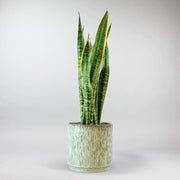Restore by Night Plants
Calathea 'Orbifolia'
Marble Queen Pothos
African Milk Tree
Syngonium 'Pixie'
Janet Craig Fragans
Snake Plant Zeylanica
Snake Plant 'Metallica'
Ponytail Palm
Hawaiian Palm
The former encourage sleep at night and alertness during the day; the latter improve our ability to focus on work and everyday tasks. Learn more about sleep and circadians rythms.
Sleep and Circadian Rhythms
On some level, we all know that being in nature is calming. The other side of Restore is about helping our bodies maintain their natural rhythms.
Plants have internal cellular clocks, just like we do. We know this because when plants are deprived of light and other queues pertaining to the natural environment, they continue to behave according to the rhythms of the day.
Some plants respond to the time of day more emphatically than others. Calatheas are a particularly good example: at night, the leaves of Calatheas close shut and the plant releases higher levels of oxygen (making it a Breathe/Restore double whammy).
Research in this area is in its infancy, but at least one study has found empirical support for the theory: A paper published in the Journal of Geriatric Psychiatry found that indoor plants improved the quality of sleep and cognition in Alzheimer’s patients, whilst reducing agitation.
This may be related to the shared circadian nature of plants and humans, the calming effect that plants have, or another unknown property. But, if you want a good night’s sleep, testing the theory yourself couldn’t hurt!



















































